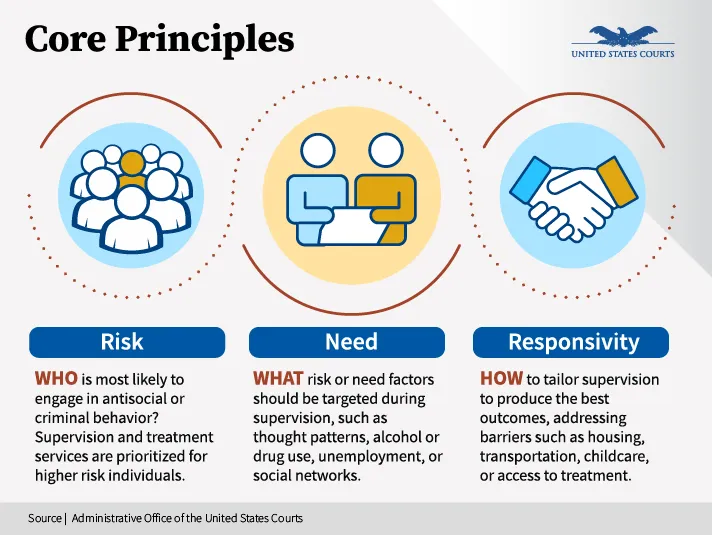Probation and pretrial services officers are committed to using evidence-based practices (EBP) to promote public safety and positively impact the lives of people on supervision.
What are Evidence-Based Practices?
Evidence-based practices involve the conscientious application of social science research and other available data to inform policies and practices that aim to achieve maximum and measurable reductions in recidivism. The Risk-Need-Responsivity Model is used to guide effective assessment and supervision practices in the federal system.

The Risk-Need-Responsivity Model
The foundation of effective supervision in the federal system is an officer’s ability to understand an individual’s risk of committing future crimes and to understand the areas of an individual’s life that, with intervention, can decrease the risk. Research demonstrates that using risk to guide decision-making improves outcomes.
The Risk Principle
Officers can have the greatest positive impact when they focus their time and resources on higher risk people on supervision and expend fewer resources on lower risk individuals.
To assess risk, officers use a scientific tool called the Pretrial Risk Assessment (PTRA) to predict a defendant’s risk of failing to appear in court or committing new crimes or technical violations while awaiting trial. To assess risk for people on post-conviction supervision, officers use a scientific tool called the Post Conviction Risk Assessment (PCRA) to predict an individual’s risk of re-offense and to identify issues that require intervention.
Individuals who score higher on risk assessments generally require more intensive services. Those with lower scores may require less attention and may have limited involvement with the court or probation officer. By considering each person’s risk level, officers avoid over-supervising lower risk individuals, and they can focus their time and resources on people who need the most support.
The Need Principle
Interventions are most successful when they are tailored to factors specifically tied to criminality, such as cognitions (patterns of thinking), substance use, and associations and activities related to criminal behavior.
Officers are trained to address factors tied to risk when recommending special conditions for release and when interacting with people on supervision. Officers rely on data from the pretrial interview, charging documents, interviews, and other sources to make a determination of an individual’s risk level and needs. For example, special conditions requiring drug testing and treatment might be recommended for someone with a history of drug use. Officers also discuss with the individual the people, places, and situations that may negatively affect their risk and stability in the community.
The Responsivity Principle
Interventions are more effective when they focus on reducing barriers specific to an individual’s unique circumstances or characteristics. For example, someone may fail to attend court ordered treatment because of a lack of motivation. Or they may face other barriers such as a lack of transportation, childcare, or housing. Officers work with individuals to address responsivity factors and reduce barriers. They also coordinate or partner with public and community resources to provide needed services.
Evidence-Based Supervision
Throughout an individual’s term of supervision, officers conduct an ongoing assessment of risk, need, and responsivity and develop individualized supervision strategies that promote success. The supervision process is dynamic. Officers use a set of skills, known as core correctional practices, to increase motivation and target factors tied to criminality.
Core Correctional Practices are skills or techniques that aim to reduce the risk of recidivism. They include relationship building skills, techniques to change criminal thought patterns, the effective use of reinforcement and disapproval to influence behavior, and helping individuals develop social skills and problem-solving abilities.
